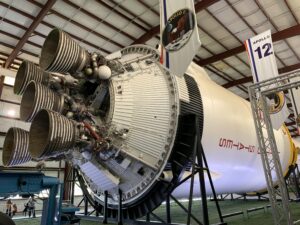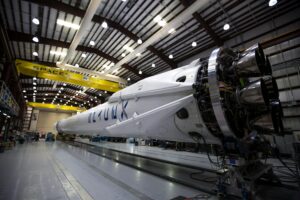Sunita Williams has safely returned to Earth after a groundbreaking space mission. This journey, a part of NASA’s success, ended with a safe landing. It was a major achievement in space exploration.
Her mission included important experiments and repairs at the International Space Station. These efforts were crucial for space research.

During her time in space, Williams spent over 300 days. She broke records and made significant scientific contributions. This mission shows NASA’s dedication to human achievement in space.
Key Takeaways
- Sunita Williams’ mission completion adds to her legacy as one of NASA’s most accomplished astronauts.
- Her safe return marks a key step in ongoing efforts to explore space sustainably.
- NASA mission success includes breakthrough data from experiments on the International Space Station.
- The astronaut return highlights the teamwork behind every space mission.
- Public interest in space exploration grows as Williams shares her experiences upon landing.
Who is Sunita Williams? A Brief Introduction to America’s Star Astronaut
Ever wondered how a naval aviator becomes a top NASA astronaut? Let’s dive into the Sunita Williams biography. We’ll see her journey from the start to her amazing NASA career.
Sunita’s Background and Early Career
Sunita graduated from the U.S. Naval Academy in 1989. As a naval aviator, she flew combat planes. Her skills in both grit and technology were unmatched. NASA chose her in 1998, starting a NASA career marked by achievements.
Previous Space Missions and Accomplishments
- Logged over 50 hours in spacewalks, including a record 29 hours in one mission.
- Became the first astronaut to compete in the virtual Paralympic marathon from space.
Her astronaut achievements include commanding the International Space Station. She showed leadership in extreme conditions.
Why She’s a Role Model for Aspiring Astronauts
As a female astronaut, Sunita broke barriers, proving STEM fields welcome diversity. Her determination through tough training and missions inspires young women. “Success isn’t about perfection—it’s about trying,” she once said. This attitude makes her a lasting inspiration.
Inside Her Latest Space Mission: Goals and Achievements
Sunita Williams played a key role in her latest mission on the International Space Station (ISS). She worked on important technology and research for deep space. Her tasks included keeping the station running smoothly and overseeing space station experiments.

She was also involved in the Boeing Starliner mission. This mission tested the spacecraft’s ability to work with the ISS. Her team’s success here means future missions to the Moon and beyond will be easier.
- Biomedical studies: Tracking astronaut health in microgravity to prevent muscle atrophy.
- Material science tests: Observing how metals behave in zero gravity for next-gen spacecraft design.
- Earth observation: Monitoring climate patterns using ISS instruments to improve environmental models.
Williams also handled daily tasks like air quality checks and robotic arm operations. Her leadership during upgrades kept the ISS efficient. Her work is crucial for long-term space living and future Mars missions.
The Journey Back to Earth: Sunita Williams Return Home
Every Earth return mission ends with a thrilling finale. Sunita Williams’ spacecraft re-entry needed perfect timing and teamwork. It’s a test of technology and human strength, from the fiery descent to a safe landing.
Re-entry Procedure and Challenges
Before re-entry, the spacecraft adjusts its path to enter Earth’s atmosphere. Here’s what happens:
- Undocking: Detaching from the ISS without hitting anything.
- Descent: Using thrusters to begin falling towards Earth.
- Heat Shield Activation: Withstanding over 2,500°F from atmospheric friction.
| Phase | Step | Key Challenge |
|---|---|---|
| Undocking | Aligning spacecraft | Preventing collision |
| Atmospheric Entry | Heat shield integrity | Temperature control |
| Touchdown | Parachute deployment | Timing accuracy |
Landing Details and First Moments
After astronaut landing, recovery teams quickly assist. Sunita’s gravity readjustment starts right away. Here’s what happens next:
- Helicopters and ground crews meet the capsule quickly.
- Astronauts get medical checks to check balance and muscle strength.
- Equipment is secured, and data from the Sunita Williams return home is analyzed.
After months in space, Sunita’s first steps might feel shaky. But her strength is clear—proof that Earth’s pull can’t dim a pioneer’s spirit.
Scientific Contributions: What Her Mission Taught Us
Sunita Williams’ mission brought us space research results that change our future. Her microgravity experiments on the International Space Station are key. They show us new ways to innovate.
Experiments Conducted in Space
- Biological studies: Looked at how cells grow in space station research conditions.
- Material science: Tested new alloys in zero gravity.
- Human health: Studied muscle loss and recovery on long missions.
Data Collection and Research Implications
NASA scientists use NASA scientific data to help astronauts and improve Earth technologies. For example, protein crystal research could lead to new medicines. These discoveries also help us explore deeper space.
How You Can Follow the Scientific Findings
Keep up with public science engagement through NASA.gov or their social media. They share space research results live. You can also join educational webinars and citizen science projects.
Life in Space: Behind-the-Scenes of Sunita’s Mission
Imagine waking up in the ISS living quarters without gravity. Sunita’s day started with no jolt from an alarm. Her breakfast was rehydrated coffee and a tortilla packet, all part of careful space meal preparation.
Every action in space needed zero gravity adaptation. Brushing teeth was done in a cloth bag. She also exercised for 2 hours daily on a treadmill to prevent muscle loss.

“The walls might be metal, but home is where your mission is,” Sunita joked in a live chat with students.
Living in space living conditions was creative. Showers were not like on Earth—she used wet towels and no-rinse shampoo. Sleeping was in a bag in her ISS cabin.
Meals were NASA’s creations, like shrimp cocktail or jollof rice, heated in a special oven. Exercise was key to prevent bone loss without gravity.
- Meals: Packaged food reheated in orbital kitchens
- Hygiene: Wet wipes and vacuum-sealed trash systems
- Exercise: Treadmill with bungee cords to mimic Earth’s resistance
Days felt like 16 sunrises to Sunita. She stayed connected with family through video calls. Living in the ISS meant tight storage and sleeping upside down.
Small comforts, like Earthly music or photos, made the ISS living quarters feel like home. Life in space is about adapting, one floating spoon at a time.
What’s Next for Sunita Williams After Her Return
After coming back to Earth, Sunita Williams starts a detailed astronaut rehabilitation program. This post-flight recovery phase works on getting her muscles strong again and balancing her body after being in space. Astronaut medical monitoring by NASA helps them use her health data for safer future space missions.

Recovery Process for Astronauts
Her recovery has three main parts:
| Phase | Timeline | Focus |
|---|---|---|
| Initial Recovery | First 2 weeks | Medical checkups and light exercise |
| Physical Reconditioning | 1–6 months | Strength training and balance exercises |
| Long-term Monitoring | 6+ months | Health data collection for future crews |
Upcoming Projects and Future Goals
While she recovers, Sunita works on important NASA projects, like:
- Designing better crew support systems
- Mentoring new astronauts for missions
- Reviewing safety for future space missions
Her knowledge also helps in improving astronaut medical monitoring. This ensures data from her recovery helps future astronauts. Keep an eye out—her insights might help us take our next big step into deep space.
Conclusion: The Legacy of Sunita’s Space Journey
Sunita Williams’ mission is more than just her story. It shows how women in space are shaping our future. Her work on the ISS pushed the limits of what’s possible. It proves that skill and curiosity can lead to great achievements.
Her journey has a big impact on us all. By setting records and leading missions, Sunita inspires many. Her success shows us that with determination and science, we can overcome any challenge.
Think about how Sunita’s work connects to your life. Her experiments might improve life on Earth or help us reach Mars. Keep up with NASA to see how her work continues to inspire new projects. Sunita’s legacy is not just in space but also in the curiosity she sparks in us all.
FAQ
What was the duration of Sunita Williams’ latest space mission?
Sunita Williams’ latest space mission lasted for several months. During this time, she did many scientific experiments. She also helped with new technologies on the International Space Station.
What challenges did Sunita Williams face during re-entry?
Sunita Williams faced many challenges during re-entry. These included extreme temperatures and the effects of gravity after being in space for a long time. NASA made sure she was ready for these changes.
How does Sunita Williams inspire young astronauts?
Sunita Williams is a role model for young astronauts, especially young women in STEM. Her hard work, skills, and leadership inspire many to dream big in space exploration.
What scientific contributions did Sunita make during her mission?
Sunita conducted experiments in biology, physics, and materials science during her mission. Her research is important for future space missions and could lead to new medical treatments on Earth.
How can I stay updated on the scientific findings from her mission?
You can stay updated on Sunita’s mission data through NASA’s website, research papers, and social media. They share new findings and updates regularly.
What did Sunita’s daily routine look like aboard the ISS?
Sunita’s daily routine included work, exercise, and leisure. She stayed healthy by following special exercise plans for living in zero gravity.
What happens during the recovery process for astronauts like Sunita?
After returning to Earth, Sunita went through a recovery process to adjust to gravity. This included physical rehab and medical monitoring. It helped NASA understand the effects of long spaceflight.
What future projects might Sunita Williams be involved in?
Sunita Williams might work on training future astronauts, improving spacecraft design, or on NASA projects. She might also return to space for future missions.












